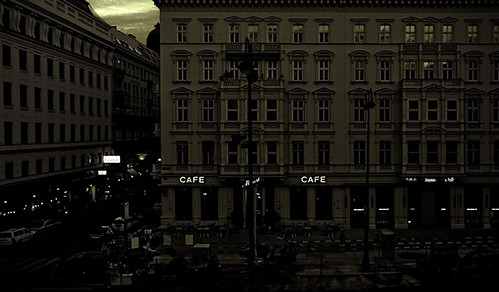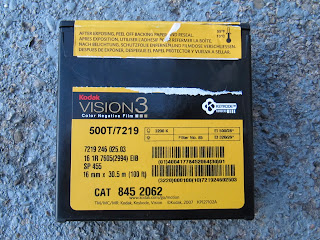Although they are different films, the final scene in Rififi reminds me of the title sequence in The 400 Blows. Shots of the sky, rooftops and monuments in Paris. I love the way this movie opens, the music is so sweet and leads into one of my favorite and most poignant stories in cinema.
Wednesday, February 15, 2012
Tuesday, February 14, 2012
Ex-Patriot Noir
As I've said before, I love urban location shoots in old movies. A lot of Film Noirs were shot on location in LA. Although Film Noir is primarily an American art form, some Noirs were shot overseas, especially in France. Film Noir was well received by French film critics, it was the French who coined the term "Film Noir"- évidemment. Bob le Flambeur, Elevator to the Gallows and Breathless all have some Noir elements. And as for location shoots, I love the Parisian footage in these films. J'adore. One of the earlier French Film Noirs came about after an American director had ended his career in the US.
Jules Dassin's directing career was put on hold during a ridiculously dark period of American political history. He was part of the Hollywood Blacklist and was barred from working after he shot Night and the City. A few years later, he was living in Europe and he was given the opportunity to direct Rififi. At the time Rififi had been in development for a couple of years and Jean-Pierre Melville was going to direct it. I suppose the production team were excited at the chance to have a real American Film Noir director helm the picture.
Rififi is gritty, dark and bleak. Dassin only shot at night and on overcast days, no sun shines in the film. There is a thread of betrayal and regret that runs through the story. Dassin was still working through his blacklisting, and the lead actor Jean Servais accepted the part for lower wages after his career had stalled due to his alcoholism. Dassin loosely adapted a script from the novel Rififi. The story moves and leads up to an awesome 30 minute silent jewel heist. My favorite part of the film is at the end when the mortally wounded Tony (Servais) gets in the car with a little boy and they drive through Paris. The little boy happily tumbles around the car, blood drips down Tony's legs and a useless suitcase of loot bobs around the backseat. As Tony looses consciousness he looks at the sky and we can see the trees and rooftops of Paris. The feeling is frightening but dreamlike.
I found the scene on youtube! Someone recorded it off the Sundance Channel-the end scene starts at 5:43
- Melville supported the choice of Dassin as the director of Rififi. Melville later used some of the work and research he did for Rififi in his awesome movie The Red Circle (Le Cercle Rouge). The Red Circle also includes a silent jewel heist. The earlier noir film Asphalt Jungle is another film to utilize the silent jewel heist-
Sunday, February 12, 2012
She was breathing deeply, she forgot the cold, the weight of beings, the insane or static life, the long anguish of living or dying. After so many years running from fear, fleeing crazily, uselessly, she was finally coming to a halt. At the same time she seemed to be recovering her roots, and the sap rose anew in her body, which was no longer trembling. Pressing her whole belly against the parapet, leaning toward the wheeling sky, she was only waiting for her pounding heart to settle down, and for the silence to form in her. The last constellations of stars fell in bunches a little lower on the horizon of the desert, and stood motionless. Then, with an unbearable sweetness, the waters of the night began to fill her, submerging the cold, rising gradually to the center of her being, and overflowing wave upon wave to her moaning mouth. A moment later, the whole sky stretched out above her as she lay with her back against the cold earth.
Albert Camus
image- Édouard Boubat
Wednesday, February 8, 2012
Some words about Kodak
My brother Brennan came home from Japan for the holidays. It was great to see him (it had been three years). We had both studied film and made our own projects but we had never worked together. So we decided to shoot something while he was home. And we decided we'd shoot on film. I had made a couple of projects that were influenced by Douglas Sirk's melodramas, but I'd shot everything digitally. Sirk's films were shot in Technicolor and he really took advantage of the medium. His films were rich, saturated color. So we decided to shoot a one reel melodrama. We were visiting our parents up in Milwaukee and we had to make sure we had everything up there to do it. I got the Bolex out and cleaned it. I went to Xav Le Plae's Riverwest Film Video and bought a roll of Vision stock. The film was tungsten balanced and since we were shooting outside, I needed to find an 85 filter. I used to have some tucked in my camera case but they're long gone. Thankfully North American Camera had some filters and Bob, the proprietor asked, "Did you just wake up and decide to shoot a film?" We basically did. My friend Heather Vernon took the train up from Chicago to act in our little production. And together with a powder blue dress, we shot some emotive stuff in the park. There were some blowing leaves and everything (WOTW). It was a great day and I look forward to seeing our finished product. The roll is in the fridge awaiting processing (an old habit...).
Last month Kodak announced plans to file for bankruptcy. It was sad to hear but not surprising. When I worked at Helix I would get memos from Kodak regarding which products and stocks they were discontinuing (it was sad when they discontinued the slide projector). I never was too interested in a film/video debate. I enjoy and appreciate the facets and practice of shooting on both mediums. I'm planning on shooting my upcoming Science Fiction Noir on Super 16 and I know it's going to be pricy but I want to shoot my Noir on film. And I'm happy I still have the option to.
Last month Kodak announced plans to file for bankruptcy. It was sad to hear but not surprising. When I worked at Helix I would get memos from Kodak regarding which products and stocks they were discontinuing (it was sad when they discontinued the slide projector). I never was too interested in a film/video debate. I enjoy and appreciate the facets and practice of shooting on both mediums. I'm planning on shooting my upcoming Science Fiction Noir on Super 16 and I know it's going to be pricy but I want to shoot my Noir on film. And I'm happy I still have the option to.
Subscribe to:
Posts (Atom)


